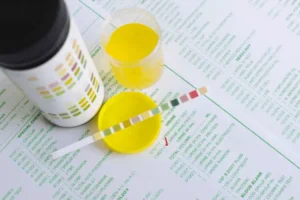
Additionally, levels of temptation and depression, but not anxiety, withdrawal severity, or treatment effectiveness, improved favouring treatment. In total, 55 primary outcome measures were used (inclusive of variations) 93 times (as some studies had multiple primary outcomes). The most common primary outcome measure reported was abstinence (51 times, 55%), followed by cravings (10 times, 11%). For abstinence, urine drug screens (UDS) were used 41 times (80%) and analysed or defined in 16 different ways. The most common method for analysing UDS was weekly proportion of AMPH/MA-free UDS, or overall proportion of AMPH/MA-free UDS. There were 75 distinct secondary outcomes inclusive of variations and often analysed differently to the primary outcomes of the same domain.
- When patients appear intoxicated and have symptoms consistent with amphetamine toxicity, testing for metabolites of amphetamine can be useful to confirm a diagnosis of the condition.
- Different mechanisms leading to a 50% reduction in monoamine reuptake produced by a classical reuptake inhibitor versus a competitive substrate (releasing agent).
- Studies eligible for the meta-analysis were reviewed for availability of data and authors were contacted to obtain missing data.
- We approached this report as a systematic review of the peer-reviewed literature, and present the methods and results in accordance with the Preferred Reporting Items for Systematic Reviews and Meta-Analyses (PRISMA) statement [22].
Amphetamine dependence
As you seek out more of a substance, it may lead to taking dangerously harmful doses or mixing substances that can be life-threatening complications like overdose. Studies conducted in (e.g. men who have sex with men) or excluding (e.g. women) specific populations are limited in their ability to generalise to other populations. For example, no study we reviewed here assessed specific populations such as indigenous peoples. Similarly, while women were often excluded by the study design, no study examined only women. It is unknown how generalisable any of the results reviewed here are outside of the context in which they were conducted, and it is unwise therefore to combine results across populations. In baseline light-MA users or in men, bupropion demonstrated a reduction in MA use [60].
Challenges in Overcoming Amphetamine Withdrawal
This was done by looking at the graphical display of the results but also by using Chi square tests of heterogeneity. A p‐value being less than 0.05 of a Chi‐square test was indicated the significant heterogeneity of a data set. The statistical methods for dealing with a data set with significant and non significant heterogeneity https://ecosoberhouse.com/ were described in ‘Data synthesis’. In addition, the causes possibly leading to the significant heterogeneity of a data set were discussed. All outcomes were reported for the short term (4 weeks or 1 month), medium term (more than 4 weeks or 1 month to 12 weeks or 3 months), and long term (more than 3 months).

Withdrawal symptoms

This four-arm trial assessed different doses of ondansetron (0.5 mg, 2 mg, 8 mg po OD) against placebo in measures of abstinence, use, severity of dependence, withdrawal, craving and retention in treatment. There was no observable difference in any outcome measure between doses or against placebo. The authors suggest that the nil result may be due to the short half-life of ondansetron (approximately 5 h) and suggest a sustained-release formulation or more aggressive dosing may give more efficacious results. In reality, there is little abuse of these drugs by patients with ADHD (Merkel and Kuchibhatla, 2009), and in most cases the challenge for the prescribing doctor is to keep the patients taking their medication rather than limiting its use. Many teenage patients stop using despite the drugs having clear benefits for their school performance; they cite reasons such as feeling too controlled, wanting empowerment from medication, etc. Stimulants have a tendency to be liked by a certain proportion of the population, though not by everyone by any means.
- In the case of IR d-amphetamine, its maximum subjective effect occurred much earlier than lisdexamfetamine, and switching to the intravenous route speeded up IR d-amphetamine’s onset of action and increased its potency.
- Despite our best attempts at extracting data on all use patterns, we found that the measures of use were so heterogeneous that they precluded all but the bluntest comparisons.
- As with similar stimulants, methamphetamine is most often used in a “binge and crash” pattern.
Among the pressing issues in healthcare is the challenge of addiction recovery, especially when it comes to substances like amphetamines. Additionally, we’ll highlight how sober living environments combined with technology can provide support during recovery. We have conducted a global review of existing evidence on the association between the use of amphetamines and major mental health amphetamine addiction outcomes. We found elevated levels of psychosis, depression, suicidality and violence amongst people who use amphetamines. There was significant heterogeneity in the magnitude of associations between studies showing that this is likely to vary depending on the study setting and methods. The evidence in support of a likely causal association varies by outcome (discussed below).


Mirtazapine has not been shown to be effective for amphetamine withdrawal, although the number of studies is limited. At present, there is no evidence to guide selection of medications that might relieve symptoms of amphetamine withdrawal for patients in initial abstinence from chronic amphetamine use. In summary, the results showed some benefits of amineptine in the treatment of amphetamine withdrawal, as seen in the discontinuation rate and improvements in the global state as measured by CGI. There were no direct benefits of amineptine on withdrawal symptoms or craving. Mirtazapine was no more effective than placebo in terms of discontinuation rate, improvements on global state, and reduction in withdrawal symptoms based on the results of one study (Cruickshank 2008).

Associated Data
- Although racemic α-methylphenethylamine (amphetamine) was discovered by Barger and Dale in 1910, it was not until 1927 that this molecule was first synthesised by the chemist, G.
- Stimulants have a tendency to be liked by a certain proportion of the population, though not by everyone by any means.
- Similarly to hypertension, hyperthermia may abate with the treatment of agitation.
- Although adherence was reported in most of the studies reviewed here, the methods and definitions were discordant across studies.
- A comparison of the pharmacodynamics and pharmacokinetics of orally versus intravenously administered 50 mg lisdexamfetamine.
In total, 39 (90.7%) were placebo controlled, while the remaining four studies (9.3%) were designed with a treatment-as-usual or alternate treatment arm as the control [36, 49, 61, 66]. Although in vitro experiments provide a good insight into individual mechanisms, the efficacy of amphetamine relative to other indirect monoamine agonists, for example classical reuptake inhibitors, can only be estimated from in vivo experiments. Although racemic α-methylphenethylamine (amphetamine) was discovered by Barger and Dale in 1910, it was not until 1927 that this molecule was first synthesised by the chemist, G.